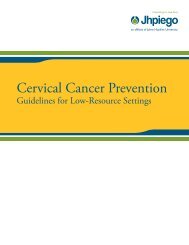Manual for Male Circumcision under Local Anaesthesia
Manual for Male Circumcision under Local Anaesthesia
Manual for Male Circumcision under Local Anaesthesia
Create successful ePaper yourself
Turn your PDF publications into a flip-book with our unique Google optimized e-Paper software.
<strong>Male</strong> circumcision <strong>under</strong> local anaesthesia<br />
Version 3.1 (Dec09)<br />
All men have occasional penile erections during sleep, and young<br />
men frequently get erections during the day. After the circumcision,<br />
the man will still have erections, which will not disrupt the process of<br />
wound healing. If, during the immediate recovery period, there is a<br />
particularly prolonged or painful erection, it can be stopped by letting<br />
the client inhale one ampoule of amyl nitrate.<br />
Instructions <strong>for</strong> the client<br />
It is very important to in<strong>for</strong>m the client that he should avoid sexual<br />
intercourse and masturbation <strong>for</strong> 4–6 weeks after the procedure, to<br />
allow the wound to heal. A condom should then be used to protect the<br />
wound during every act of sexual intercourse <strong>for</strong> at least six months.<br />
Thereafter condoms should always be used to prevent sexually<br />
transmitted infections, HIV or unwanted pregnancy.<br />
The dressing applied during surgery should be removed 24–48 hours<br />
later, provided that there is no bleeding or oozing. If there is any<br />
bleeding or oozing, a new dressing may be applied <strong>for</strong> a further 24–48<br />
hours, and then checked again. Once bleeding has stopped, no<br />
further dressing is necessary and the patient should be instructed to<br />
wear freshly la<strong>under</strong>ed, loose-fitting <strong>under</strong>wear. Underwear should be<br />
changed each day. After the dressing has been removed, the man can<br />
shower twice a day, and should gently wash the genital area with mild<br />
soap (baby soap) and water. (This advice may be adapted according<br />
to local conditions, including the availability of facilities <strong>for</strong> washing<br />
and showering.)<br />
Be<strong>for</strong>e discharging the client, make sure that he <strong>under</strong>stands that<br />
complications are infrequent, but that he should:<br />
• look <strong>for</strong> signs of potential problems, namely:<br />
• increasing bleeding,<br />
• severe pain in the penis or genital area,<br />
• inability to pass urine, or severe pain when passing urine,<br />
• discharge of pus from the surgical wound<br />
• increased swelling;<br />
• return to the clinic immediately or seek emergency care if a<br />
problem develops.<br />
Make sure the client knows where to go if complications arise.<br />
Give the client postoperative instructions, verbally and in writing, if<br />
appropriate (see Appendix 7.1). Ask him to repeat the instructions, to<br />
make sure that he has <strong>under</strong>stood them. Give him any medications<br />
prescribed, and arrange an appointment <strong>for</strong> follow-up (see below).<br />
Check that a responsible adult is available to accompany the client<br />
Postoperative care and management of complications Chapter 7-2
















